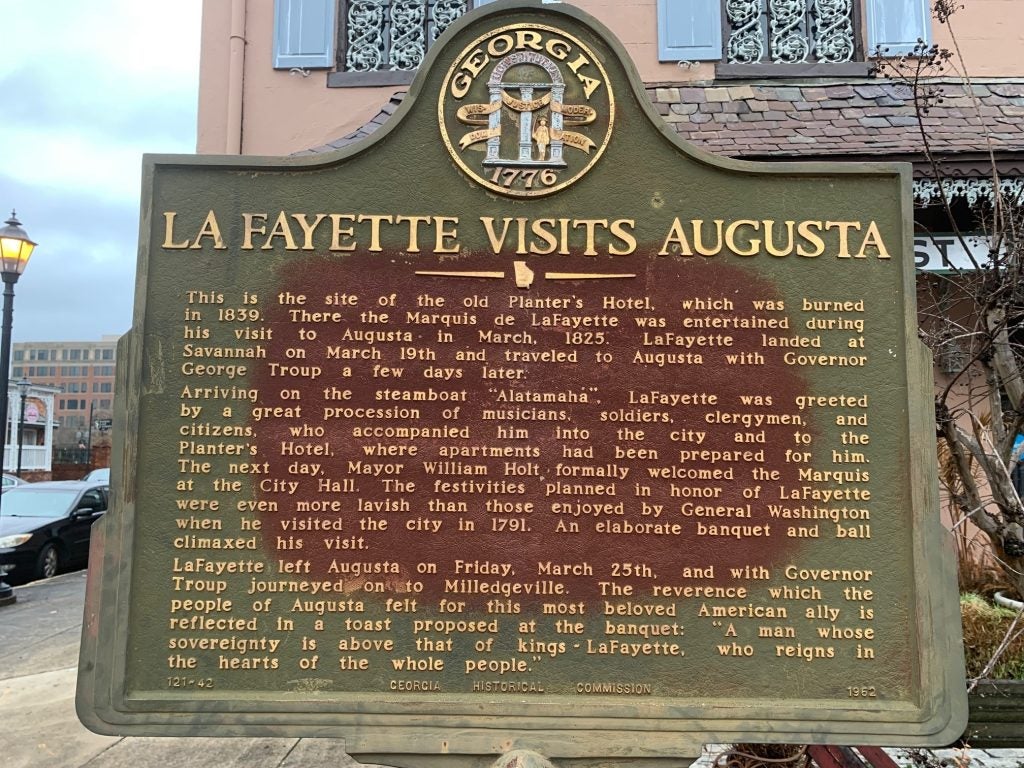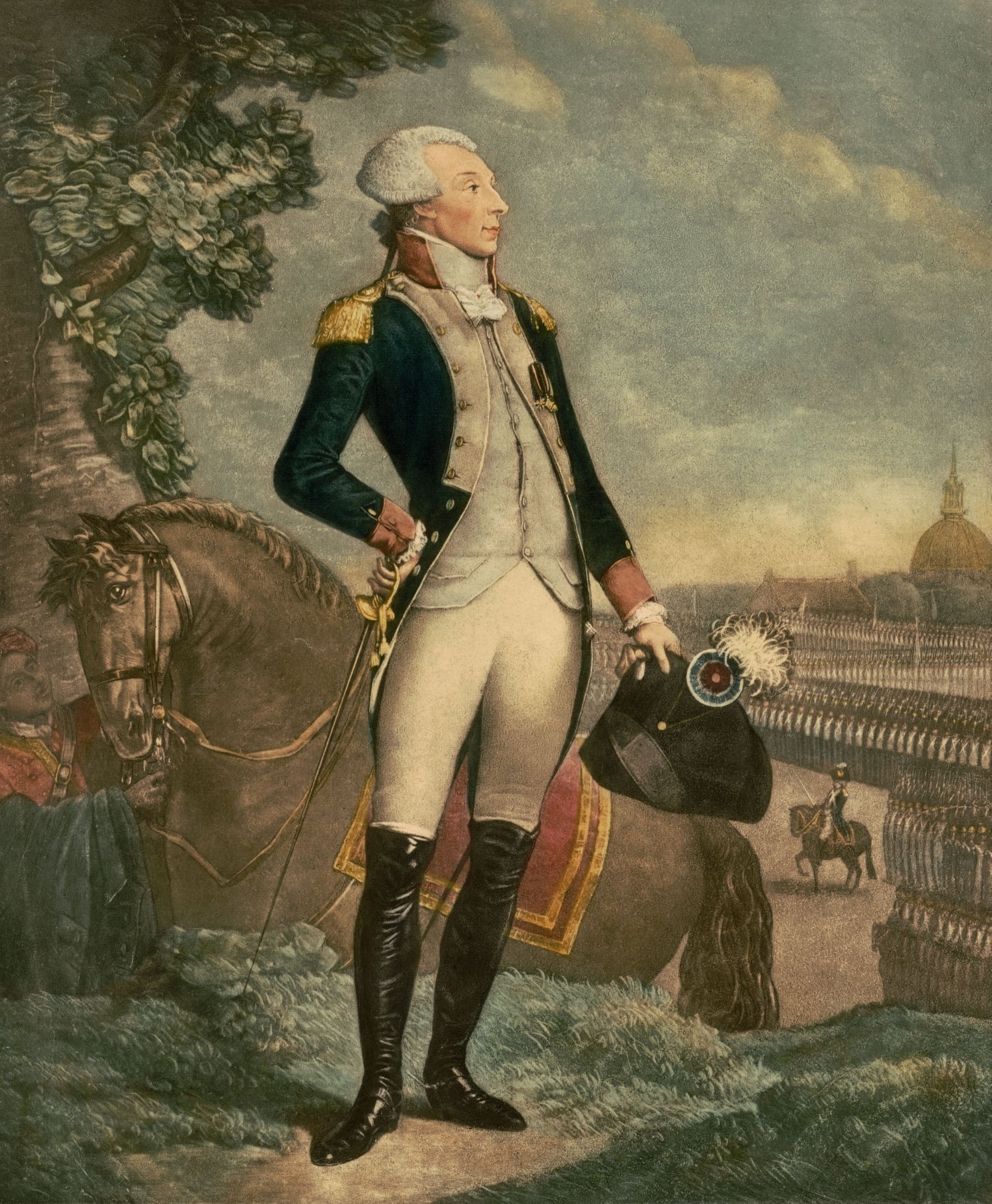Augusta has had its share of visiting luminaries, but one such visit may have outshone them all, including a visit from this nation’s founder.
That visitor was the Marquis de Lafayette came to town.
George Washington’s visit to Augusta in May 1791 was somewhat low-key compared with the visit some 30 years later by the man Washington called his “son.”
Augusta, at the time of Washington’s visit, was still pretty much a frontier town, according to late Augusta historian Ed Cashin in his history of the city. While crowds heralded Washington as he entered the city on his white horse, the biggest event was Washington’s review of the cadets of the newly created Richmond Academy.
But “crowds” is a relative term, and there just weren’t that many people living in Augusta when Washington came to town.
However, by 1825, with the introduction of the steamboat, Augusta was on its way to becoming an important inland port city. When city leaders found out that Augusta was on Lafayette’s itinerary, word spread quickly, and the city went into overdrive to welcome the Revolutionary hero.
MORE: How to dispose of last year’s Christmas tree

Storefront windows were dressed up, and merchants ordered “Lafayette hats” and commemorative coins to sell to the crowds.
According to Cashin’s history, one hardware merchant, John Bones, lamented to his mother in a letter that he wished he owned a “fancy goods” store instead of just a hardware shop.
Cashin writes in his book, “The Story of Augusta,” that a large arch was placed on Broad Street, and the Shultz Bridge, which did not exist in Washington’s day, was covered in American flags. A special platform was constructed in front of the Greene Street courthouse large enough for 600 people to enjoy lunch with Lafayette when he arrived.
As the time neared, lookouts were placed on the lower Savannah River to keep watch for the steamboat Altamaha as it rounded the sandbar carrying Lafayette into Augusta.
Upon arriving, the Bunker Hill hero was met with a parade of marching bands and rifling troops as thousands of onlookers lined the streets to catch a glimpse of the revolutionary rockstar.
According to Cashin, by the time Lafayette departed four days later, he had been treated to speeches from Augusta’s dignitaries, banquets in his honor and a ritzy ball at the Planters Hotel, to which one ticket cost $8 or $200 in today’s money.
So, who was Lafayette?
Born in France in 1757, Marie Joseph Paul Yves Roche Gilbert du Motier, Marquis de Lafayette was never a fan of the British as his father was killed in the Seven Years War when Lafayette was 2 years old.
Ironically, it was the brother of King George III, the Duke of Gloucester, who informed Lafayette of the plight of the North American colonies. Flush with cash from several inheritances and seeking adventure, the 19 year old secretly booked passage to America in 1776, just as things were getting exciting, according to Historic Valley Forge website.
Upon arrival, Lafayette was commissioned a major general, but that was due to his social status, as the young man knew virtually nothing about warfare. However, he proved his fearlessness and eventually began a friendship with Washington.
After winning over skeptics with his courage at the Battle of Brandywine in 1777, Lafayette encamped with the men at Valley Forge and witnessed the suffering as the rag tag army had no provisions and many of the men did not have shoes in the winter.
MORE: Pickleball is arising in Augusta as a new favorite sport
According to George Washington’s Mount Vernon, Lafayette spent his own money to buy food, clothing and muskets for men under his command.
When a coup attempt against Washington began being plotted, Lafayette sided with Washington and helped keep the “Conway Cabal” from becoming a reality and stayed by the General’s side as the war turned against the British.
After returning to France, Lafayette found his home country lurching toward revolution. With the assistance of Thomas Jefferson, Lafayette wrote the Declaration of the Rights of Man and of the Citizen, which according to the Palace Élysée website, has been a cornerstone of every French constitution since the end of the French Revolution.
While Lafayette was a revolutionary, he was a moderate and did not favor overthrowing the monarchy of Louis XVI. He protected the king by moving the royal family to Paris after the storming of the Bastille and attack on Versailles.
To avoid the fate of other moderates during the Reign of Terror, Lafayette fled to Austria where he was held as a political prisoner for nearly a decade, according to the Lafayette College website.
After his tour of America celebrating the 50th anniversary of the Declaration of Independence, Lafayette returned to France only to witness the Revolution of 1830. The elderly Lafayette was offered the throne of France, and he declined.
Lafayette was made an honorary citizen of the United States in 2002 by Congress, joining Mother Teresa as one of the only two people to receive the honor.
…And that is something you may not have known.
Scott Hudson is the senior reporter for The Augusta Press. Reach him at scott@theaugustapress.com












